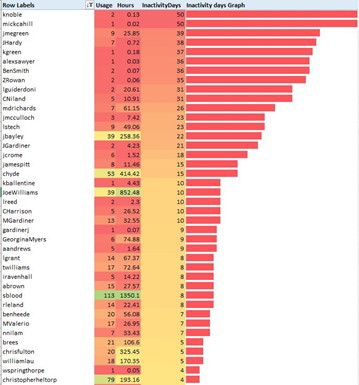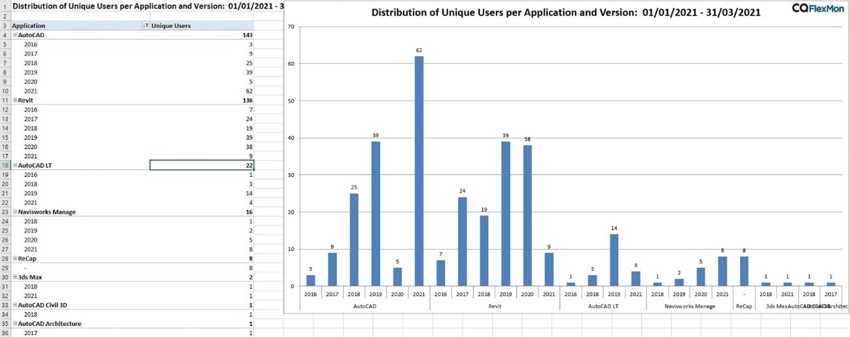What is simulation?
A simulation is an imitation of a real system or process. It is used to understand, predict, or analyze how a system behaves under different conditions.


It’s common for organisations to lose track of what licences they have for what software, and who the users are, or are supposed to be. Some look upon the task as an admin headache, some simply regard it as not very important. Yet precision in managing licenses can bring enormous benefits to any business. Here’s why you should know everything about your software portfolio.
Uncontrolled software licensing can cause problems you may never know are happening. You may be paying for software that never gets used as often as you thought it might when you first deployed it. You may also be underpaying. If the latter situation sounds like a win for the business, it isn’t.
If you receive an audit from the software vendor, and you are in violation of the terms of your agreement—no matter how unwittingly—they will have no hesitation in levying fines. The bigger the company, and/or the more widespread the unlicensed use of the software, the heavier the fines will be. They can run into thousands. They can run into tens of thousands.
That may sound harsh, but the income for software vendors lies in the licensing payments they receive. They have a right to protect it and to protect their IP. Those are the rules of the game; best adhered to. It’s best to be confident that you have an up-to-date overview of what you use, what you pay for, and what benefits you can gain by aligning the two more closely.
Lack of control is never a deliberate strategy. It’s entirely understandable why it happens. When you correlate the number of individual software applications you have in your business, with the other variables that effect the number and types of licences you should be paying for, the landscape can be very changeable. These other variables include:
Consider again those risk scenarios that arise from anything less than a diligent approach to licensing management: paying too much/paying too little (buying too many licences/not buying enough).
The first of these is simply wasted expenditure. I said that any skewed approach to licensing management can lead to problems you may never realise are happening; they can run on for years. The incoming bills pass smoothly through to department heads to approve, they glide on to accounts payable. They live quietly in the background. Unspoken acceptance that everything is okay simply merges into the way things are done. No problems come to the surface. You’re not even out of compliance, so nobody will ever bring the situation to your attention. You can be sure that if you’re paying too little, then the vendor very soon will be in touch. Both situations can be very easily avoided without the licensing issue taking on enormous admin proportions.
Symetri provides a software monitoring solution designed to deal with the problems and risks I’ve outlined above, while also enabling you to go one step further; to optimise how you work. It’s not just about avoiding problems, it’s also about realising the full potential of your teams.
Our solution is called CQFlexMon. It gives you the tools to monitor software assets so you can track usage, ensure vendor licence compliance, control costs, and finally weed out those problems that may well be tucked deep within your software portfolio. CQFlexMon gives you control and visibility across all your licences—from Autodesk, to Microsoft, to any other vendor product; basically, any executable file.
You should also take note to identify software vendors terms and conditions to ensure you remain compliant. CQFlexMon enables you to easily detect any anomalies.
Not everybody uses all the software you have, all the time. Whilst a certain role may require daily and day-long use of an application, other use cases may be more sporadic and depend on ad hoc usage by an individual or at a certain stage of a project. If use cases are not fully analysed and understood they can lead to licensing issues. CQFlexMon enables you to see exactly what the usage rates are, enabling you to align your licences to your points of software need:
1. Autodesk Usage Inactivity

2. Autodesk Unique Users per Version

3. Autodesk Yearly Versions Network Licence Manager report

An overarching consideration to have a firm grasp of is the way in which licences are moving away from the traditional Network Licence. This is likely to have an impact on your business. From February 2023, Autodesk will only offer named user licences. Multi-user licences will no longer be available. While you will already have a certain number of licences to assign to your users, the requirement now is that you need to assign and de-assign the licences manually. This can create an admin overhead for IT staff if your licence count is close to your number of users. Infrequent users of the software would have to have a licence assigned to them and taken away instead of opening and closing the licence manager doing the work.
CQFlexMon informs the decision-making process regarding how many licences you have and what type of licences you require, by analysing the Network Licence Manager data. You’ll be able to identify infrequent users who might require a simple AutoCAD licence (or even a viewer), and frequent users of multiple products who need an AEC Collection suite.
Above all, the ‘Flex’ in FlexMon points to its flexibility, provided by a set of modules from which you can select those most pertinent to the way you run your business. I’ll be looking at each module in three forthcoming blogs:
In the meantime, if you want to discuss any aspect of your licensing concerns, please get in touch with us at sales@symetri.ie. Take a look at CQFlexMon here.
A simulation is an imitation of a real system or process. It is used to understand, predict, or analyze how a system behaves under different conditions.
Learn what design means and how different types of design are used in the construction industry. Streamline your project with Symetri's digital solutions.
In this guide, we'll explain what a BOM is, how it works, and why it's a critical tool for product success. Whether you're a beginner or looking to optimize your BOM processes, this is your ultimate resource.
